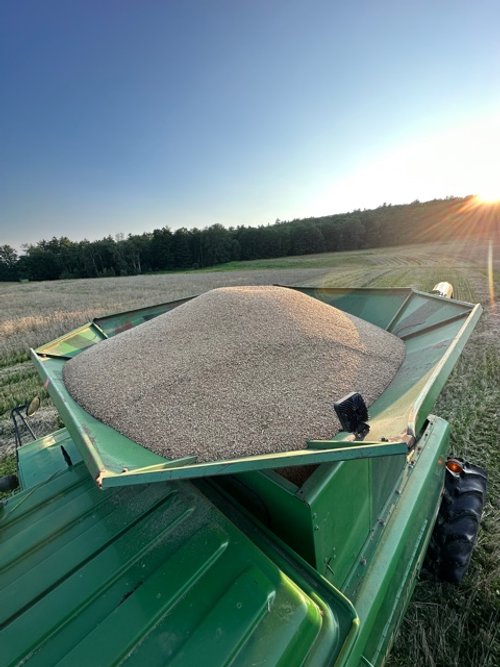
Harvesting, Processing and Storing
Once you have made it through the growing season the time has come to harvest grain from the field. Grain harvest in the Northeast typically occurs between July and August depending on the grain type, variety, planting date, and weather conditions. As grains approach readiness for harvest, they will go through a maturation process in which grain develops protein and starch. This stage of grain development is often referred to as “soft dough” in which individual grains are soft enough to be squished between the fingers. As the grain matures, plants will senesce showing yellowing to browning leaves as well dry down of the entire plant, leading to more brittle stems. Upon further maturation the grain will harden into what is known as the “hard dough” stage where individual grains will physically dent when pressed. At this point, grains may be physiologically mature, however grain moisture may be more than 25%. Ideal moisture for harvest begins at ~18% however moisture appropriate for grain storage is between 12 and 14%. Often grain is harvested at a higher moisture than required for storage due to weather conditions. This means drying will be necessary to make sure the grain can be stored safely.
Depending on the size of the operation, the type of equipment needed for harvest will vary. Regardless, being prepared and having harvest equipment available and properly adjusted for the grain and the conditions is critical to success. If using a combine, take the time to adjust your equipment’s settings (including speed, augers, and cylinders) to avoid losses, damaged grains, and optimize overall grain quality. Read this article for more information on equipment for harvesting grains: Buying Your Dream Machine (pdf by Ken Van Hazinga). There are many good articles online that provide information on combine adjustments. A few are listed below.
Combine Adjustments. 2018. University of Wisconsin, Corn Agronomy Program. http://corn.agronomy.wisc.edu/Management/L036.aspx
Setting Combines for Harvesting Best Quality Seed and Field Corn. 2003. Iowa State University. https://store.extension.iastate.edu/Product/Setting-Combines-for-Harvesting-Best-Quality-Seed-and-Field-Corn.
Strategies for Harvesting High Quality Malt Barley in the Northeast. University of Vermont. https://www.youtube.com/watch?v=Mb4UWqn82xo
Lazor, J. (2013). The organic grain grower: Small-scale, holistic grain production for the home and market producer. Chelsea Green Publishing.
Logsdon, G. (2009). Small-scale grain raising: An organic guide to growing, processing, and using nutritious whole grains for home gardeners and local farmers. Chelsea Green Publishing
After harvesting your grains, access to suitable storage is imperative to prevent spoilage or loss due to pests. This will vary once again on the scale of your operation ranging from small metal or plastic storage containers to grain silos. Even once in storage, it is critical to monitor moisture levels and take the necessary precautions to dry your crop down accordingly. If stored wet, grains can develop mold growth, toxins, rancidity, and excess heat. This can also be attractive to various insect pests. Click here for a printable PDF on Using Farm Moisture Testers, courtesy of Iowa State University Extension. Most grain can go into storage at higher moisture contents than recommended, but it will be necessary to provide aeration and possibly heat to bring moisture down to acceptable storage levels. Milling grains should be stored at about 12.5%, soybeans at about 13%, and corn at 13.5%.
When drying grains, the best aeration system is one that uses low temperatures and long drying times to achieve the desired moisture content. Many grain bins have built-in blowers to force air into the grain and continue drying; you can also improvise with fans and blowers. Grain-growers and processors recommend aerating grains that are above 14% moisture, but also checking for condensation as temperatures change throughout the storage period.
Containers or bins used for grain should be rodent- and insect-proof and should also be cleaned and sanitized before crop storage. Ambient temperatures should be maintained to reduce potential condensation inside a storage bin. Maintaining lower temperatures within the storage area allows for greater storability as long as grains remain dry, with recommended temperatures ranging between 41°F and 50°F for long-term storage. The articles below provide greater detail on storing and monitoring grain in storage.
Managing Dry Grain in Storage. 1995. Purdue University. https://www.extension.purdue.edu/extmedia/aed/aed-20.html
Strategies to Store High Quality Malt Barley in the Northeast. University of Vermont. https://www.youtube.com/watch?v=XE-GxyrFJnE
Grain Quality – It’s Time to Check Your Stored Grain. 2022. Purdue University. https://extension.entm.purdue.edu/newsletters/pestandcrop/article/grain-quality-its-time-to-check-your-stored-grain/
Please refer to the following guides and resources for more information on producing and storing grains:
UVM NWCS – Cereal Grains and Dry Beans. University of Vermont. https://www.uvm.edu/extension/nwcrops/grains
Growing Organic Cereal Grains in the Northeast. University of Vermont.
Cereal Rye Production Guide. University of Vermont.
Guide to Malting Barley Production in the Northeast. University of Vermont.
Northeast Dry Bean Production Guide. University of Vermont.
